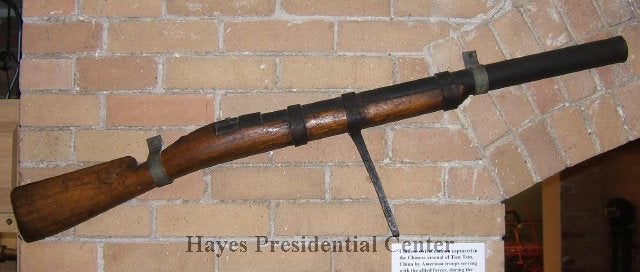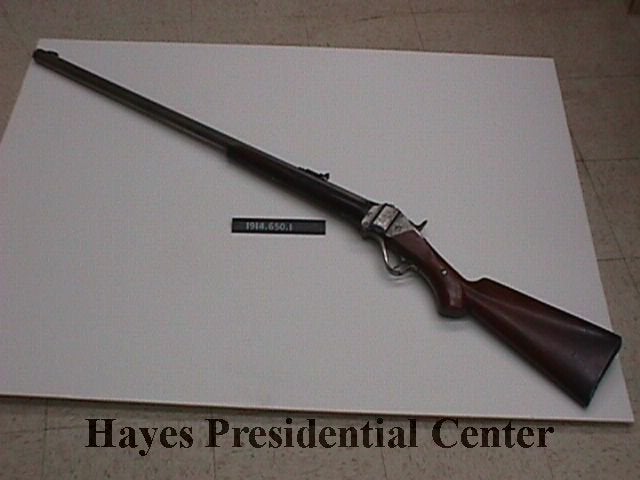Admittedly, the Rutherford B. Hayes Presidential Library & Museums was not a place that I expected to have an impressive collection of firearms, both on display and in storage.
Located in Fremont, Ohio, the facility, which also includes Hayes’ impressive 31-room mansion, is actually the first-ever presidential library and it is privately owned and operated. (Unlike the ones run by the National Archives.)
Hayes is one of five Presidents to have served in the Union Army during the Civil War. Interestingly, all of them were born in Ohio, but Hayes is the only one to have been wounded in combat. At the 1862 battle of South Mountain, Hayes was hit in the left arm just above the elbow.
An entry in his diary recounts the event:
Fearing that an artery might be cut, I asked a soldier near me to tie my handkerchief above the wound. I soon felt weak, faint, and sick at the stomach. I laid down and was pretty comfortable. I was perhaps twenty feet behind the line of my men, and could form a pretty accurate notion of the way the fight was going. The enemy’s fire was occasionally very heavy; balls passed near my face and hit the ground all around me. I could see wounded men staggering or carried to the rear; but I felt sure our men were holding their own. I listened anxiously to hear the approach of reinforcements; wondered they did not come.
The only other president to be wounded in battle was James Monroe at Trenton in 1776.
Input from TFB Writer Miles Vining-
Note the specific mention of the correct use of a tourniquet, cutting off blood circulation to an afflicted limb and realizing the need to stop the bleeding. During the Civil War Hayes would have been a high-ranking officer, so it could be possible that such knowledge might have existed among more educated classes of American society. But the fact it did exist is some testament against the misconception that surgeons of both sides didn’t understand the medical science they were practicing.
Because of Rutherford’s time in the Army, there was the standard array of Civil War arms that I expected to see. Included in this category were then-Brigadier General Hayes’ Smith & Wesson Model No. 2 Army revolver and a Colt Model 1860 Army with a fluted cylinder, of which they only made approximately 4,000. The frame is cut for a shoulder stock, which was done at the factory, but the nickel finish was definitely done later. The original holster for the Smith & Wesson is also on display, along with a really cool pocket knife shaped like a running dog.
A number of other Civil War-related arms are also on display. These include a Colt Model 1851 Navy taken off of one of Morgan’s Raiders; a Richmond-made copy of the Sharps carbine; and a wide variety of arms either carried or captured by members of the 23rd Ohio Volunteer Infantry, which was Hayes’ unit.
There’s also a large collection of later period arms of both domestic and foreign manufacture, many of which have interesting provenance. The majority of these firearms were originally part of Webb Cook Hayes’ collection. Webb served as a major with the First Ohio Cavalry during the Spanish-American War, and found himself engaged in Havana and Santiago, Cuba, including the infamous fight at San Juan Hill. He also served in the Philippine Insurrection as a Lieutenant Colonel of the 31st US Infantry and was awarded the Medal of Honor for his participation in a rescue mission on Vigan Island. (Both his original medal and the one of new design are on display.) Participation in the Boxer Rebellion, the China Relief Expedition, and the Russo-Japanese followed. Rounding out his military career was WWI service with the rank of Colonel as the regional commander of the American Expeditionary Force on the Italian front.
Webb acquired an eclectic assortment of arms during his travels. These include a rampart gun captured from the Imperial Palace near Peking; a swivel gun from the Chinese arsenal at Tien-tsin, China; General George Crook’s Sharps “Old Reliable” hunting rifle; a Mauser Model 1898 captured by Webb at Yauco, Puerto Rico, and carried for the rest of the campaign; a Remington Rolling Block captured by Webb on Vigan Island; and a Colt Model 1878 that Webb was carrying when he participated in the action that qualified him for the Medal of Honor.
The most unusual piece (to me, anyway) from Webb’s collection was an Austrian carbine that had been converted from flintlock in a manner that I had never seen. The original hammer was removed, but the frizzen spring was retained. A percussion hammer was altered and installed upside down atop the spring so that it fired with the hammer falling backwards.
The museum’s arms collection also includes a wide variety of swords, bayonets, daggers, and even some cannon. A cartridge collection that spans from the Civil War to the present is also mounted in one of the display cases. My personal favorite in there is a round for the Billinghurst-Requa battery gun.
Another impressive display is a room that houses artifacts related to other presidents, including signed documents from every president dating back to George Washington mounted on a wall in front of an exact replica of the iconic Resolute Desk, which was given to Hayes by Queen Victoria. (My wife refused to take my photo sticking my head through the door on the bottom, a la JFK Jr.)
For a facility dedicated to a president who goes largely ignored in history, it was a really great museum with an unexpected yet impressive arms collection. If you ever find yourself near Fremont, Ohio – perhaps as you head to Camp Perry, only 20 minutes away – I’d recommend stopping by and spending a few hours there. It is definitely worth it.
 Your Privacy Choices
Your Privacy Choices















